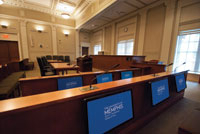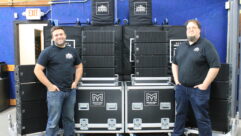

Technology in the Court
Nov 17, 2010 12:00 PM,
By Dan Daley
State-of-the-art mock courtrooms demonstrate future courtroom technology.
Sidebars
State-of-the-art Courtroom Template
The University of Memphis Law School moved into a new home, the 125-year-old former U.S. Postal Service Customs House, after its former facility faced flooding and overcrowding. With part of a $42 million budget, Conference Technologies created a state-of-art facility for the school’s future lawyers.
Photo by Pamela Becker
Perry Mason would have little trouble finding his way around a 21st-century U.S. courtroom. Technology in most of them still tends to be comprised of basic AV systems, even as criminal justice moves deeper in new fields like DNA. But a template for the future can be found in Memphis, where the University of Memphis Law School needed a new home. A flooding basement and a flawed HVAC system, as well as major overcrowding problems, had plagued the school’s existing plant for the previous decade. Fortunately, the school did not have to look far: The 125-year-old former U.S. Postal Service Customs House in downtown Memphis was the perfect fit. The school was able to acquire the historic structure in 2005 for a reported $5.3 million, but it would take another $42 million and nearly five years to bring it up to date, including the installation of what many would agree is the most state-of-the-art mock courtroom in the world—and one that will provide a template for future systems designs for American courtrooms.
Historic Issues
From 1885, when the building opened, until 1963, the 140,000-square-foot facility—more than twice the size of the school’s previous location—served as the federal courthouse and was the site of every major federal case in Memphis. It was placed on the National Register of Historic Places in 1980, with architectural credentials such as original brass window cages and hardwood paneling. In 1990, one of the courtrooms gained some cinematic recognition as the set for one of the more gruesome scenes in the film The Silence of the Lambs.
Rechristened the Cecil C. Humphreys School of Law as part of its new mission, five large classrooms with tiered floors and state-of-the-art AV/IT features were incorporated into a structural addition that had been put on in 1903, which is located in the center-rear section of the facility. Of those rooms, two stand out as the route that legal education is taking in the 21st century, with systems installed and integrated by Conference Technologies (CTI).
The historic mock courtroom is more heavily surveilled than Times Square. Four Sony EVI-HD1 PTZ high-definition cameras cover the room from several angles. Two are soffited in the large judge’s bench that dominates the front part of the 43’x40′ room. These are focused into the courtroom, with the two counsel tables in the foreground and the audience behind them. Another EVI-HD1 is positioned on the wall opposite the jury box; a fourth is mounted on the rear wall and provides an overview of the entire proceedings in the room. These are controlled with Sound Control Technologies RC2-DDS remote controllers. Lighting and motorized shade functions are also controlled from the judge’s bench.
Audio is captured via Listen SW6000 conference management software and a DCS 6000 system that’s similar to those used by the United Nations and other legislative bodies. Nine Listen DM 6060 microphones are placed at key locations in the room, including six for each position in the jury box and one each at the judge’s bench and two counsel tables. A Sabine SGM14 gooseneck-mounted microphone is also positioned on the mobile podium between the bench and tables.
1
Technology in the Court
Nov 17, 2010 12:00 PM,
By Dan Daley
State-of-the-art mock courtrooms demonstrate future courtroom technology.

Law students at the University of Memphis Law School learn the ways of defense and justice in the school’s mock courtroom. Here, a combination of audioconferencing, flatscreen, and control technology keep these systems within reach during trial sessions but subtly hidden within the historical architectural details.
Photo by Pamela Becker
That podium is a marvel of gear being packed into a decorous yet utilitarian enclosure that is both a media port and a lectern. Inside, a JVC SR-MV50US S-VHS/DVD/DVD-R combination recorder/playback device, an Extron MTP RL 15HD A SEQ VGA input for laptop computers, and an Elmo P30S document camera act as the portals for data for presentations and evidence given by counsel or by the class professor. The lectern user can see the input display on a 24in. Elo TouchSystems 2420LB touchpanel screen that is electronically annotatable, using a Crestron DVPHD dual processor.
As technically intricate as they are, the lecterns were the center of some turbulence during the project. Dave Lahey, CTI’s estimator, who became the project manager on the job, recalls that at first the school had indicated that it would provide the 18 lecterns that would be used throughout the school. In June 2009, several months into the systems part of the renovation, it became apparent that the lecterns were going to be significantly delayed. The opening day for the facility was slated for Jan. 20 2010; the lecterns arrived exactly one month before that. Upon delivery, CTI’s crew saw that the manufacturer had interpreted a 19in. standard rack size as the interior dimension, making it too small to be fitted with the Middle Atlantic racks CTI had planned to install. “We later found out that the manufacturer’s claim to fame was building furniture for Motel 6,” Lahey says dryly.
The crew worked feverishly in their own workshop over Christmas to get two lecterns for the mock and moot courtrooms ready in time. Thanks to some neat wiring and bypassing, they gave the dignitaries the appearance of flawless operation, which all of them achieved over the next several months as integration continued. “We made sure that the very next bid we did the lecterns would be part of our package,” Lahey says.
All of the input ingested by the lecterns’ systems can be routed to any of the display screens around the room. These include six Dell E248WFP 24in. 1920×1200 widescreen LCD screens in front of each juror position, supported by Chief Manufacturing wall mounts, as well as one for each counsel table and one for each judge’s bench. A Digital Projection Titan HD-600 720p/8000-lumen projector, lowered from a recession in the ceiling in the rear of the courtroom, illuminates a 150in.-diagonal Draper motorized screen that drops down in front of the judge’s bench.
2
Technology in the Court
Nov 17, 2010 12:00 PM,
By Dan Daley
State-of-the-art mock courtrooms demonstrate future courtroom technology.

In the moot, or debate, courtroom, two Panasonic TH-65PF10UK 65in. flatscreen plasma displays are mounted on the front wall above the bench. Anchoring these displays required drilling from the other side of the wall with steel rods that are able to support a 240lb. integrator—a demonstration Conference Technologies technician Joel Crotts conducted during the installation.
Photo by Pamela Becker
All of the input sources and displays are under both local and remote control. The former is via an Extron CrossPoint 450Plus 16×8 switcher mounted in a Middle Atlantic rack under the judge’s bench, with an Extron WPB 103G with audio wall plate for control by the judge. For the latter, signals are routed to a basement control room three stories away over Belden UTP Cat-5e cabling. There, a 32×32-channel Extron CrossPoint 450Plus matrix allows the master engineer to route any combination of signals back to any display in the mock courtroom, or to any of the other wired rooms in the teaching complex (such as a moot courtroom), or to the Accordent Technologies Media Capture station system that assigns ID information to every video. The school’s library can then issue that ID number to anyone wishing to access that data, with metadata that can provide information on who watched the material, when and where (either in the school’s video access system or via the Internet), and for how long. It operates in conjunction with a Polycom HDX9002 high-definition videoconferencing system in the master control room that can be shared among any of the rooms in the audiovisual system. The system’s complex programming was done by Lee Baker, a master Crestron programmer.
“It’s an enormous amount of data, and there’s a huge amount of information that can be taken away from how it’s used,” says Joel Crotts, lead technician for CTI.
Not Changing History
Crotts says a major part of the project’s mandate was to not affect the aesthetics of the building. “The grid lines of downtown Memphis were laid out from the cornerstone of this building, so you get an idea of how historically important it is to the city,” he says. After a gorgeous plaster ceiling fresco had been discovered behind a decades-old dropped ceiling, the university wanted to restore the entire building to as much of its former Greek Revival grandeur as possible, but still not impede the integration of all the technology its faculty could wish for.
The adjacent moot (debate) courtroom has much of the same AV technology as the mock courtroom. Notable exception are two Panasonic TH-65PF10UK 65in. flatscreen plasma displays mounted on the front wall above the bench instead of a projection screen. Mounting these displays illustrated how tricky historical buildings can be to work within. The brick wall on which the displays were to be mounted was nearly 2ft. thick. The solution was to drill through the wall from the opposite side and insert a steel rod, which was anchored with a large wooden washer. On the other side, to establish that the rod and wall would adequately support the display, Crotts gave it what he says was the ultimate test: The 240lb. integrator hopped up and held onto the protruding pipe long enough to satisfy himself, saying, “If it can hold me, it’ll hold the display.”
Cabling throughout the structure was fairly straightforward, using new conduit and trays where possible. The only real glitch came when the installers realized that they needed to run shielded Cat-5 cable for the Danish Interpretation Systems (DIS) audio system (distributed and supported through Listen Technologies). “The design of the DIS system uses digital signals for all of the audio streams to the microphones and speakers,” Lahey says. “The shield is a necessary component in the system to remove and prevent any noise on the cable and eliminate any lost information in the system. For instance, in World Court proceedings and language interpretation, a lost or misheard syllable can be a very big deal.”
Sound in the courtroom is via wall-mounted Renkus-Heinz ICX7 passive loudspeaker columns, which allow the sound to be highly controlled and directed only toward the coverage areas.
The mock courtroom is also fitted with a Listen LT82 assisted listening system for translation and hearing-assisted applications. “We took it to another level,” Crotts says, noting that they switched out the system’s usual RF operation for an infrared system. “The reason was to inhibit crosstalk to wireless systems in this room and other rooms.” (The mock courtroom is equipped with a Sabine SWM7213-H-U-M1 wireless microphone system.)
The University of Memphis mock and moot courtrooms are not what most lawyers would expect to see when they walk into court today. “They’re way beyond anything else that’s out there in any government building now,” Crotts says. But they will become a template for how courtrooms will change and evolve as the law, in an era of DNA testing and GPS surveillance, heads into its own technology-laden future.
3









